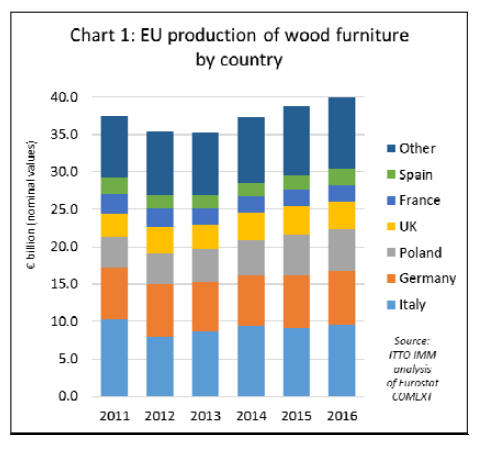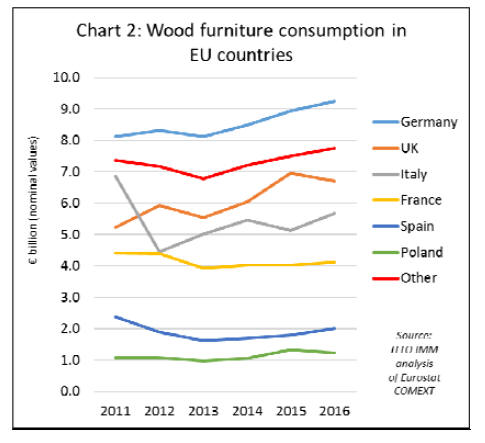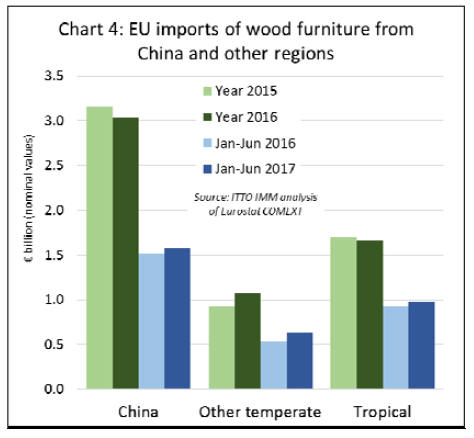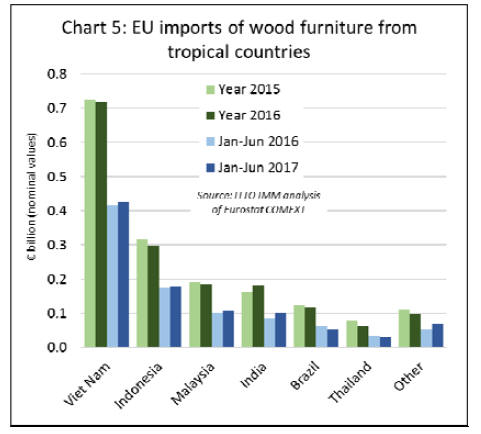|
Report from
Europe
Tropical and Chinese suppliers claw back EU
furniture
market share
Previous ITTO reports have highlighted how European
furniture manufacturers have been taking larger share of
the internal EU market in recent years, gradually
squeezing out overseas competitors.
This trend has been driven partly by increased price
competitiveness at a time when the euro and other
European currencies have been weak relative to the US
dollar.
There are also more enduring factors, including the
underlying strength of European furniture manufacturers
and their brands in terms of innovation and design; the
obstacles to overseas suppliers complying with complex
EU technical and environmental standards; and the
expansion of furniture manufacturing in Eastern Europe, a
location which combines ready access to raw materials,
relatively cheap labour, and the internal EU market.
The latest Eurostat data shows that European
manufacturers share of the EU internal market increased
even more sharply last year than indicated by preliminary
estimates. However, there are also signs that suppliers in
China and South-East Asia are clawing back some market
share in 2017.
Analysis of official Eurostat manufacturing production
data for 2016, just released in August, shows that wood
furniture production value in the EU increased by 3.3% to
Euro40.1 billion last year (Chart 1).
That is the highest level of production since 2008. It is
also greater than the preliminary estimate of 2016
production of Euro39.6 billion reported in the previous
ITTO TTM report on the EU wood furniture market
published in May 2017 (based on analysis of EU trade
flow volumes and other indices of furniture business
activity).

Economic stimulus in Italy behind rise in furniture
consumption
According to the latest Eurostat data, EU wood furniture
consumption increased 3% to Euro36.7 billion in 2016.
This compares to the preliminary estimate of Euro36.1
billion reported in the ITTO TTM report in May.
The latest Eurostat data reveals that wood furniture
consumption in Italy increased by more than 10% in 2016,
to Euro5.7 billion, recovering ground lost the previous
year (Chart 2). This is a much larger increase than initially
predicted given widespread reports of slow economic
growth and weak consumer confidence in the country.
However, Italian furniture consumption last year was
boosted by the Italian Stability law implemented in
January 2016 to support the national economy. The law
included tax credits for building renovation work,
including a bonus for new furniture, and direct public
support for the “Made in Italy” brand.

In addition to Italy, wood furniture consumption increased
in several other key EU markets in 2016 including
Germany (rising 4% to Euro9.2 billion), France (rising 2%
to Euro4.1 billion) and Spain (rising 12% to Euro2
billion).
These gains offset a 4% decline in consumption in the UK,
a trend widely forecast owing to the economic uncertainty
and weakness of the British pound following the Brexit
vote.
Intra-EU furniture trade continues to rise
Analysis of Eurostat trade data reveals that internal EU
trade in wood furniture, which increased 4% to Euro16.2
billion in 2016, continued to rise in 2017. This trend is
driven both by the slow rise in EU consumption and by
rising dependence of the internal EU market on
manufacturers located in lower cost member states of
Eastern Europe, particularly Poland, Romania, and
Lithuania.
The EU has maintained a trade surplus in wood furniture
since 2011 when exports to non-EU countries overtook
imports from outside the EU. This surplus remained
broadly flat between the start of 2015 and the first quarter
of 2016 (averaging close to Euro3 billion per annum), as
both imports and exports were stable.
However, there were some early signs of a slight
narrowing in the trade surplus in the second quarter of
2017 (to around Euro2.8 billion per annum) as imports
began to pick up. (Chart 3).

Biggest gains in EU imports of wooden furniture are
from temperate countries
After slipping back last year, EU wood furniture imports
from tropical countries and China recovered some lost
ground in the first 6 months of 2017. EU imports from
tropical countries increased 4.5% to Euro970 million,
while imports from China increased nearly 5% to
Euro1.58 billion.
However, the biggest gains in EU imports of wood
furniture this year are from other temperate countries,
mainly bordering the EU such as Bosnia, Turkey,
Switzerland and Ukraine. EU imports from these countries
increased 20% to Euro630 million in the first 6 months of
2017, building on a 14% gain recorded the previous year.
(Chart 4).

The share of the various tropical countries in supply of
wood furniture to the EU has varied quite widely this year.
After falling 2% to Euro716 million in 2016, EU imports
from Viet Nam rebounded 3% to Euro427 million in the
first six months of 2017.
Imports from Indonesia also increased during the period,
but by only 1% to 178 million m3, not sufficient to
recover ground lost in 2016. Imports from Malaysia
recovered more strongly in the first half of this year, rising
nearly 8% to Euro108 million.
Imports from India have also continued to rise, up 18% to
Euro103 million during the six-month period. (Chart 5).

There were also significant shifts in the destinations for
furniture exported into the EU from tropical countries in
the first half of 2017. The UK imported Euro353 million
of wood furniture from tropical countries between January
and June 2017, 2% less than the same period in 2016.
Imports of tropical wood furniture in Italy also declined,
by 4% to just Euro33 million, a sign that the recent surge
in Italian furniture consumption has not been to the benefit
of tropical suppliers.
However, all other leading EU furniture markets imported
more furniture from tropical countries in the first 6 months
of 2017 compared to the same period the previous year.
Imports increased 3% to Euro139 million in Germany, 1%
to Euro134 million in France, 16% to Euro99 million in
the Netherlands, 4% to Euro43 million in Belgium, and
30% to Euro42 million in Spain. (Chart 6).

European destinations for wood furniture imported from
individual tropical countries have shifted this year. A
significant decline in UK trade with Viet Nam in the first
half of 2017 was offset by rising Viet Nam trade with a
wide range of other EU markets including Sweden, Spain,
France, Poland, Denmark, Ireland, Greece and Austria.
A decline in UK, French and Swedish imports from
Indonesia, was compensated by a rise in Indonesian trade
with Spain, Netherlands and Ireland during the six-month
period. Malaysia exported less to Sweden and Germany,
but increased sales to the UK, Poland and Ireland. The rise
in EU imports from India this year is mainly concentrated
in the UK, Netherlands and Germany.
‘Top 200’ account for nearly a quarter of world
furniture production
Of the world’s 200 top furniture manufacturers, 40% are
headquartered in the EU, 22% in North America, 31% in
Asia Pacific, 2% in South America, and 2% in central
Eastern Europe, Russia and Turkey.
The “Top 200” account for around 23% of total world
furniture production, indicating a relatively low degree of
concentration in a sector which continues to be dominated
by smaller enterprises.
These are key conclusions of a new report on the Top 200
published by CSIL, the Italian furniture industry research
organisation.
The report also highlights that around 65% of the Top 200
are involved only in manufacturing and the remaining
35% operate both as manufacturers and retailers.
The share of companies that directly manage retailing
activities increases with the size of the company.
The share is highest in the upholstered market segment
and lowest in the office and kitchen segments which tend
to be more dependent on other channels such as contract
sales and direct sales to building companies.
The Top 200 have an average turnover per employee of
USD178,000 per year, with the larger companies generally
having higher levels of productivity. This is due partly to
their greater investment in R&D and production
machinery, and a greater propensity to operate via
subcontracting and specialist production units.
The report notes that total world furniture production was
worth about USD 400 billion in 2016, a slight gain on
2015, but marginally down on 2014. However, in recent
years, world furniture trade has been growing faster than
production with greater concentration in low-cost
manufacturing hub locations.
The Top 200 are gradually increasing their share of global
production and sales. In 2016, the turnover of the Top 200
was 17% higher than in 2011, rising year-on-year more
rapidly than the market as whole.
See CSIL: ‘Top 200 Furniture Manufacturers Worldwide’ report
available at www.worldfurnitureonline.com
|